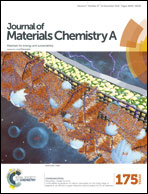A ternary blend of a polymer, fullerene, and insulating self-assembling triptycene molecules for organic photovolatics†
Abstract
Interest in ternary blend organic photovoltaics (OPVs) has been triggered by improved power conversion efficiency (PCE), simple fabrication, and a variety of material combinations. They typically consist of a p-type donor, an n-type fullerene, and a secondary p-type donor, where the two donors undergo complementary photoabsorption to increase the photocurrent. In contrast to this general strategy, we have incorporated propeller-shaped, high-bandgap triptycene (TP) into a bulk heterojunction (BHJ) composed of a conjugated polymer (P3HT, PTB7, and PffBT4T) and methano[60]fullerene (PCBM). The TP molecules self-organize into two-dimensional (2D) layers. Based on their energy levels, these layers are not expected to trap charge carriers. The performance of these OPV devices is discussed in conjunction with film morphology, transient photoconductivity, mobility, crystalline structure, and surface free energy. Herein, we demonstrate that the PCE of the crystalline polymer (PffBT4T):PCBM with 5 wt% TP is slightly improved (maximum: 9.41%, average: 8.96 ± 0.23%) without the use of a solvent additive, along with much enhanced long-term stability. This is presumably due to the presence of the TP sheet that acts as a nucleation agent and facilitates the crystallization of the polymer. The features of the TP scaffold give rise to a high-performance, additive-free ternary BHJ. Thus, further exploration through chemical functionalization of TP is warranted.


 Please wait while we load your content...
Please wait while we load your content...